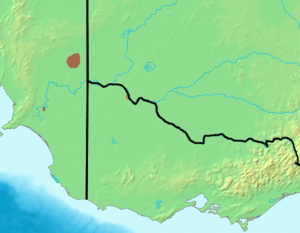Black-eared miner facts for kids
Quick facts for kids Black-eared miner |
|
|---|---|
 |
|
| Conservation status | |
| Scientific classification | |
| Genus: |
Manorina
|
| Species: |
melanotis
|
 |
|
| Distribution of the black-eared miner | |
The black-eared miner (Manorina melanotis) is an endangered honeyeater endemic to mallee woodland in south-eastern Australia.
Taxonomy
It is closely related to the much more widely distributed yellow-throated miner M. flavigula, and the taxonomic status of the black-eared miner is the subject of some controversy, with some researchers considering it a subspecies of M. flavigula.
Behaviour
Black-eared miners are co-operative breeders, living in colonies during the breeding season, and dispersing into the bush during non-breeding periods. Little is known of their movements during these periods.
Distribution and habitat
IBA (Important Bird and Biodiversity Areas), identified by BirdLife International as being important for black-eared miner conservation, are areas containing relatively intact, mallee woodland in north-western Victoria and south-eastern South Australia. They comprise Murray-Sunset, Hattah and Annuello, the Riverland Mallee, and Wyperfeld, Big Desert and Ngarkat.
Conservation status
Black-eared miners are listed as endangered on the Australian Environment Protection and Biodiversity Conservation Act 1999.
The species' conservation status in several Australian states follows:
- New South Wales: Listed as "Critically Endangered" by the Threatened Species Conservation Act 1995, as of May 2015.
- South Australia: Listed as "Endangered" by the National Parks and Wildlife Act 1972, as of June 2011.
- Victoria: Listed as "Threatened" by the Flora and Fauna Guarantee Act (1988), as of April 2015, and as "endangered" on the 2007 advisory list of threatened vertebrate fauna. Under this Act, an Action Statement for the recovery and future management of this species has been prepared.
See also
 In Spanish: Manorina melanotis para niños
In Spanish: Manorina melanotis para niños


